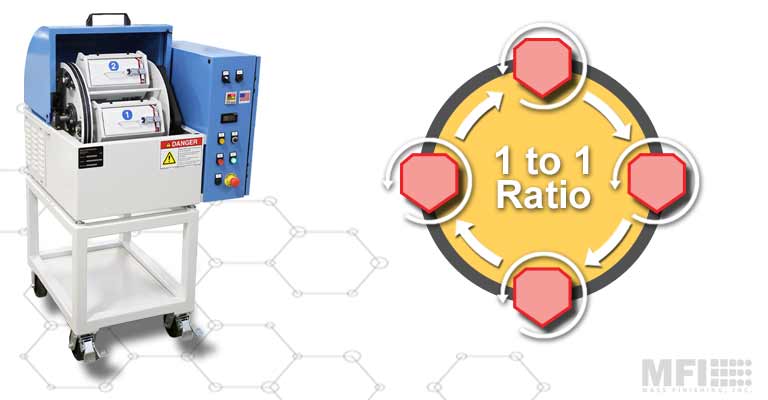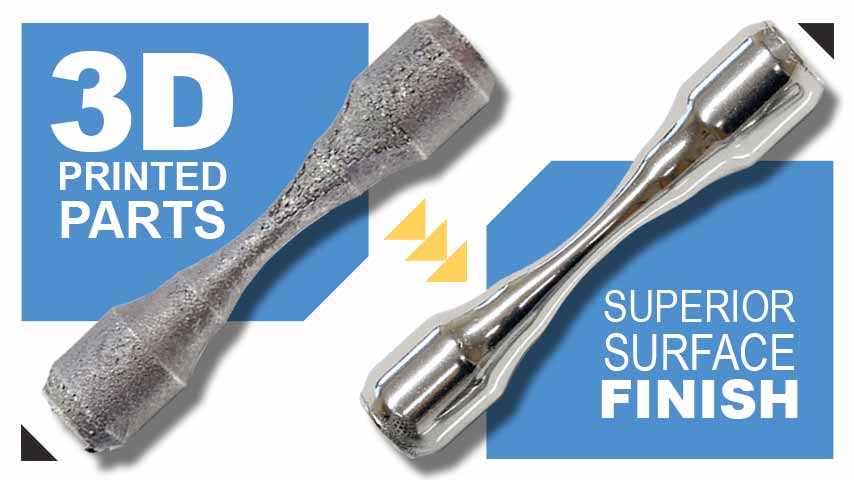While the benefits of 3D additive manufacturing are numerous, many of those using the process often fail to realize is that finishing/polishing the resulting parts can pose significant challenges. The main reason is that additive-produced part surfaces are extremely rough. Plus, they typically involve complex geometries and are grown from harder metals, like titanium, that are either impossible to finish using traditional manual methods or will require huge amounts of time to do so. To overcome these challenges, today’s additive parts manufacturers turn to centrifugal barrel, high-energy tumbler systems.
The systems not only reduce labor costs and production times, they efficiently remove surface roughness and scale to consistently generate mirror-like finishes on multiple 3D printed metal parts simultaneously while reducing part stress. Depending on the additive technology used when growing parts, each individual layer adds stress to those before it. As these parts are tumbled in a high-energy system, the action of the process relieves this built-up surface stress.
High-Energy Finishing Applies the Perfect Force
High-energy finishing machines such as those from Mass Finishing Inc. (MFI) use the pressure and friction created through centrifugal force to quickly – hours as opposed to days – remove excess material and burrs, polish part surfaces and create a uniform finish in an operation that is quieter than vibratory-type tumblers. The system achieves finishes that are isotropic, meaning parts are polished uniformly and evenly in all directions, results that are unachievable through hand finishing.

Centrifugal barrel finishing, also known as centrifugal barrel tumbling, operates on the “Ferris Wheel” principle with a one-to-one ratio of barrel rotation to turret rotation. The process involves loading one or all four chambers with a mixture of parts, water, compound, and media, which are filled to around 50%-80% capacity. As the machine rotates, the barrels spin around the turret in a planetary motion, creating a highly effective sliding force inside the barrel.
Gain Media Attention for Tough Additive Parts
For common part materials such as titanium, aluminum, inconel, nitinol, printable plastics, carbon steel, gold, and silver, the high-energy tumblers use ceramic, plastic, and porcelain media in a variety of 3D shapes and size variations for the best finishing results.
High-energy tumblers are gaining popularity and are ideal for precision part manufacturers. The systems typically have compact footprints as small as 4′ x 3′. This makes them easy to fit into most production operations without sacrificing finishing speed or results. Additionally, the compact sizes and multiple barrel styles of these systems provide flexibility for work in nearly any industry.
Conventional tumbling systems, like vibratory types, will use the same media. But without high-energy finishing, they are ineffective for additive parts. These conventional systems typically generate 1 G-force (between the media and it contacting the part). While high-energy systems operate at over 12 G-force. This is why the systems can handle tough additive-manufactured parts.
Media is often made from ceramics in shapes/geometries that include triangles, cones, cylinders, and more. Plastic is also used, as well as corn cob. For its customers, MFI provides a guide for selecting the best media for a particular application. A lot of it comes down to the size and shape of a part and its features.
Delicate part features, such as those found on dental teeth models, will require adding what is known as support material to the tumbling media. This rubbery support material helps prevent damage to fine features and additive-manufactured parts.
Some facilities, in particular those supplying the medical and dental industries, are generating high volumes of additive parts. And most of them are using either manual polishing, vibratory-based systems, or chemical processes that corrode the surface prior to a finishing process. This latter method creates health and safety hazards and environmental concerns. High-energy tumbler systems, on the other hand, achieve additive finishing and polish batches of parts in a repeatable process. It’s much faster and cost-effective, and without the safety or environmental issues.

